Simon B. Jones's Blog: Slings and arrows, page 8
December 18, 2012
A Pair of Aces – War in the air on the Eastern Front
In the summer of 1943, as the greatest tank battle of the Second World War raged in the Kursk salient, a twenty three year old pilot named Ivan Kozhedub serving with the 240th Fighter Air Regiment claimed the first of his 62 ‘kills’ in a career which would see him become the highest scoring Soviet ace of the war and would see him remarkably awarded with the title of Hero of the Soviet Union on no less than three occasions.
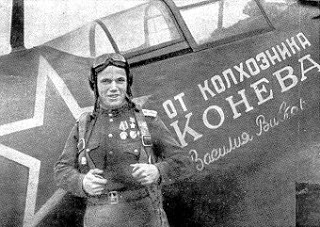 Ivan Kozhedub Kozhedub’s first success; downing a Ju-87 ‘Stuka’ dive bomber was followed within days by three more kills as he began to master his craft.
Ivan Kozhedub Kozhedub’s first success; downing a Ju-87 ‘Stuka’ dive bomber was followed within days by three more kills as he began to master his craft.Kozhedub’s ability had long been recognised but his value as an instructor in preparing new pilots for aerial combat had kept him away from the front lines until now. As his pupils had gone off to win glory in the skies, Kozhedub had chafed at being kept behind the lines and had repeatedly requested a transfer to combat duties. In March 1943 his wish was finally granted and he found himself transferred to the Kursk sector of the front.
At the conclusion of the Kursk campaign, Kozhedub, now a squadron leader, was transferred to the Dnieper front where his prodigious efforts in aerial combat soon gained recognition. In February 1944 Kozhedub was awarded the title of Hero of the Soviet Union for the first time, having claimed 27 combat kills. His feats included downing 11 enemy planes in the space of 10 days.
In July 1944 Kozhedub joined the 176th Fighter Guards Regiment on the Belorussian Front as Vice Commander. Here he conducted ‘lone wolf’ operations, flying against a Luftwaffe increasingly on the back foot in the face of growing Soviet air superiority. Flying his trusty Lavochkin La-7 ‘no. 27’ which he would keep until the end of the war, Kozhedub continued to add to his victory tally, claiming another fifteen kills including downing three of the highly rated German Focke Wulf 190 fighters in a single day. His efforts would earn him in August 1944 the accolade of Hero of the Soviet Union for a second time.
As the air war pushed on into Germany in 1945, Kozhedub scored one of his most notable victories by shooting down a Messerschmitt 262 jet near Frankfurt.
Legend also has it that Kozhedub was forced to shoot down two US P51 Mustangs over Berlin which mistook his plane for a German one.
Kozhedub survived the war, receiving a third gold star as a triple Hero of the Soviet Union at the conclusion of hostilities. In total he flew 326 combat missions, fought 126 combats and claimed 62 kills, making him the highest scoring Allied ace of the war, his refusal to share kills; crediting the other pilot instead, meant his official tally could have been much higher. He remained in the air force and commanded a clandestine unit during the Korean conflict. Kozhedub went on to reach the rank of General in the Soviet air force and died in 1991.
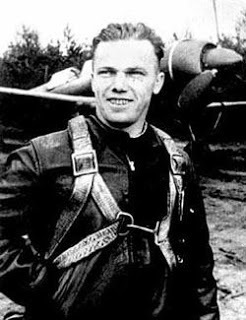 Ivan Kozhedub 1920-1991
Ivan Kozhedub 1920-1991At around the same time as Kozhedub was making his first combat sorties over the Kursk salient, a young German pilot named Erich Hartmann was making his return to active duty in the same sector of the front. Hartmann had suffered a nervous breakdown after being shot down no less than five times during his baptism of fire on the Russian front in the previous year. His experience now proved to be invaluable as he embarked on an incredible run of success against the less experienced Russian pilots many of whom proved to be no match for Hartmann in his Me109. On the first day of the German ground assault alone Hartmann claimed four kills and by August 1943 had amassed no fewer than 90 combat victories. In the course of his baptism of fire Hartmann had learned from his mentors to attack enemy aircraft by firing only at point blank range. This technique helped to garner him his incredible kill-rate but was also high risk and resulted in Hartmann being forced to land his plane, damaged by flying debris, behind Russian lines.
Hartmann was captured by Russian ground troops but by faking injury he found himself placed on a stretcher and put into the back of a truck. When the truck came under attack from German aircraft, Hartmann made a break for freedom and was able to make it back to his own lines.
Hartmann continued to serve on the Russian front as the tide of war gradually turned against the Germans, nevertheless maintaining his amazing rate of victories over enemy aircraft. He was awarded the Knights Cross in October 1943 and went on to be awarded the additional ‘oak leaves’ and ‘diamonds’; meeting Hitler on both occasions. On both occasions he caused something of a furore; on the first occasion by turning up drunk and on the second by refusing to surrender his side-arm in order to meet the Fuhrer.
In the last days of the war Hartmann found himself facing both US and Russian forces. In an engagement over the Romanian oilfields, he fought on against a squadron of P51 Mustangs until his plane both ran out of fuel and ammunition and was forced to bail out.
Hartmann claimed his last kill on the very last day of the war before surrendering his squadron to US forces. Under the terms of the Yalta agreement the German airmen were handed over to the Russian forces. Hartmann had received orders to fly west and surrender to the British but had refused to leave his comrades.
He was to spend a decade in Russian prison camps before finally being repatriated in 1955. By the end of the war Hartmann had amassed a total of 352 confirmed kills, a higher total than any other fighter pilot in history. He served for a time with the West German air force and died in 1993.
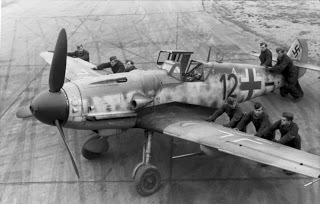 Random picture of an Me109 not related in any way to Erich Hartmann.
Random picture of an Me109 not related in any way to Erich Hartmann. More on WW2 flying aces
http://www.elknet.pl/acestory/aces.htm
Very interesting interview with Ivan Kozhedub
http://www.historynet.com/aviation-history-interview-with-world-war-ii-soviet-ace-ivan-kozhedub.htm
Profile of Erich Hartmann
http://acepilots.com/misc_hartmann.html
Battle of Kursk
http://www.historylearningsite.co.uk/battle_of_kursk.htm
Published on December 18, 2012 02:22
December 11, 2012
Doge Enrico Dandolo - Old and blind but still dangerous
Enrico Dandolo was the 39th and arguably the most remarkable Doge of Venice. He held the office from 1193 to 1205 and despite being of an advanced age; perhaps as old as 85 at the time of his accession, had an action-packed reign. Dandolo is also described as being so blind as not to be able to see his hand in front of his face but neither age nor infirmity prevented him from undertaking prodigious military efforts on behalf of the Republic.
Dandolo belonged to one of the most venerable Venetian noble families and had enjoyed a career as an accomplished diplomat and soldier by the time of his election as Doge. At the time of his accession Venice was looking to reestablish itself as the predominant trading power in the Eastern Mediterranean. This had received a major blow in 1171 when the Byzantine emperor Manuel Comnenus had rounded up and imprisoned hundreds of Venetian citizens, confiscating property and impounding ships throughout his empire in a coordinated backlash against Venetian influence. Dandolo took part in the Venetian embassy to Constantinople in the aftermath of this outrage where peace proved elusive and the envoys were treated with disdain. Dandolo is said to have lost his sight as a result of head injury received during a brawl during this embassy, whatever the truth of this, he nursed a hatred of Byzantium from that time forth.
Dandolo’s opportunity to exact the full measure of revenge against Byzantium came with the preaching of the Fourth Crusade by Pope Innocent III in 1199. This expedition, which was to be launched against Egypt, would require the significant contribution of Venetian sea power in order to transport the crusading army. This Dandolo, with a sharp eye for a profit and a determination to gain as much benefit as possible for Venice from the exercise, was happy to provide; for a price.
 Dandolo declares Venetian support for the Fourth Crusade
Dandolo declares Venetian support for the Fourth CrusadeIn return for the Republic’s assistance, Dandolo had demanded nothing less than half of all the territory captured and an up-front payment of 84,000 silver marks. At the same time it is likely that the Doge was already seeking to undermine the expedition since Venice had a vested interest in maintaining peaceful trade with the Egyptians.
When the turn out for the crusade proved to be lower than expected, the expedition’s leaders Geoffrey de Villehardouin and Boniface of Montferrat found themselves unable to come up with the required sum. Dandolo now took advantage of their embarrassment to divert the crusade to serve his own purpose. In exchange for writing off some of the debt, Dandolo proposed that the crusaders could help Venice by retaking the Croatian port of Zara from the Hungarians. To this the crusaders had little choice but to agree and the city was swiftly captured and sacked when the crusaders finally set out in 1202. For their trouble the entire crusade found themselves excommunicated by the outraged Pope for making war on fellow Christians. Dandolo, though he may now have been in his nineties had accompanied the expedition and when further opportunity to divert it from its original objective had presented itself in the form of Alexius; the dispossessed heir to the Byzantine throne, he championed the young man’s cause.
Alexius had arrived in Zara with extravagant promises of money and soldiers for their cause if the crusaders would help to overthrow his usurping uncle and restore him to power.
The forces of the Fourth Crusade duly arrived in Constantinople and swiftly forced their way into the Golden Horn. The assault upon the sea walls of the city was led by Dandolo in person, who fearlessly ordered his galley run ashore and then leapt, with sword in hand and the standard of St Mark in the other, onto the ramparts. The rest of the Venetians followed him boldly and the city was taken.
 The Venetians storm the sea walls of Constantinople The usurper fled and with Alexius restored alongside his blinded father who had been released from prison, the operation appeared to have been a success. The promised payment was once more not forthcoming however as the restored emperors found their treasury somewhat bare. One can imagine Dandolo, with theatrical exasperation, wondering aloud if any of the princes of Europe were good for their debts.
The Venetians storm the sea walls of Constantinople The usurper fled and with Alexius restored alongside his blinded father who had been released from prison, the operation appeared to have been a success. The promised payment was once more not forthcoming however as the restored emperors found their treasury somewhat bare. One can imagine Dandolo, with theatrical exasperation, wondering aloud if any of the princes of Europe were good for their debts.When a popular uprising swept aside the two restored emperors it was clear that any reward to be had from the action in Constantinople would have to be taken by force. The crusaders had withdrawn across the Golden Horn and the defences along the sea walls were being hurriedly shored up by the new emperor Alexius Ducas. In the face of this new resistance, Dandolo proposed that the city should now be taken by storm and the Empire of Byzantium should be divided between the crusaders; with Venice gaining over a third of all imperial territory.
The city fell to a renewed assault and was put to three days of systematic plundering and burning. The destruction and desecration were terrible. Even the church of Hagia Sofia was profaned; according to the Byzantine chronicler Nicetas Choniates the high altar was destroyed, a whore was enthroned in the Patriarch’s chair and mules were brought into the church to be laden with its plundered treasures.
In the aftermath the crusader Baldwin of Flanders was elected as the first Latin Emperor of Constantinople; an entity which would last for sixty years before the Byzantines succeeded in reclaiming their capital.
All of this was of Dandolo’s making. To him must go the credit for masterminding and manipulating the course of events that had brought the Fourth Crusade, which had set out to strike at the Muslim occupiers of the Holy Land through the soft underbelly of Egypt, to sack Constantinople; the greatest city in Christendom. To him also must go the bulk of the infamy that this act deserves. Through his actions Dandolo had acquired extensive new territories for the Venetian Republic which would allow her to dominate trade with the eastern Mediterranean. Ultimately however the fatal weakening of Byzantium would hasten its eventual demise at the hands of the Ottoman Turks; an event which spelled the end for the Venetian commercial empire.
Within a year of this achievement Dandolo was dead. He was laid to rest somewhat ironically in the Church of Hagia Sofia. His legacy was long-lasting and far reaching. It is to Dandolo too that we owe the curious presence in the Basilica of St Mark of the famous bronze horses which once adorned the hippodrome of Constantinople.
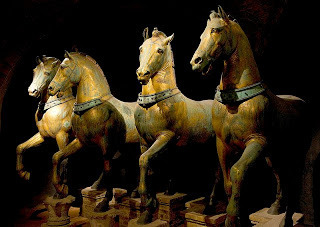 The horses of St Mark http://www.allempires.com/article/index.php?q=enrico_dandolo
The horses of St Mark http://www.allempires.com/article/index.php?q=enrico_dandolohttp://www.mlahanas.de/Greeks/Medieval/war/FourthCrusade.html
Published on December 11, 2012 02:15
December 4, 2012
Ctesiphon – Fallen city of the Sassanid Kings – Part Two
Beside the River Tigris stand the remains of the royal capital of the great rulers of the Sassanid Persian Empire. The remains of the city of Ctesiphon today lie some 20 miles from Baghdad and have seen better days. The sole surviving monument is the Palace of Khusrow known today in Arabic as the Taq-e Kisra. Only one half of the façade along with the vault of the great iwan now stand. This vaulted mud brick chamber 37 metres high and 26 metres across was at the time of its construction the largest such structure attempted. The chamber was open at the front of the building to create a dramatic archway leading into the royal audience chamber.

The palace was constructed in the reign of Khusrow I (531-579 AD) This mighty king was a contemporary of the Byzantine Emperor Justinian I and fought a series of wars against Byzantium which saw the two superpowers of their day clashing directly or by proxy in conflicts from the Yemen to Georgia. At the same time Khusrow faced the threat on his north eastern frontiers of the Hepthalites or White Huns against whom he waged a war of annihilation.
Under Khusrow, Ctesiphon became an imperial capital as never before. Khusrow took a firm grip on his sprawling territories, gathering more power unto himself than any of his predecessors at the expense of the great noble families who had ruled their own lands as little kings in their own right. Khusrow’s reforms brought the armies and the tax revenues of the Persian Empire directly under royal control for the first time. In the reign of Khusrow all roads led to Ctesiphon and these too were redeveloped to improve the speed of communications within his empire. In his quieter moments Khusrow found time to enjoy playing the game of chess, recently introduced from India.
Under Persian rule, Ctesiphon had only once been subjected to the sack at the hands of the Romans back in 283 AD when the emperor Carus had led a lightning strike down the Euphrates whilst the Persian king and his elite forces were engaged in fighting a civil war far to the east. Carus died, most probably by assassination before he could advance any further into Persia and the Romans retreated. Under Julian the Apostate the Romans had advanced to the very walls of Ctesiphon before the expedition of that remarkable emperor also met with disaster in 363 AD.
In 627 the city faced its gravest threat yet in the form of the emperor Heraclius, who, having put all the armies of the Great King Khusrow II to flight was advancing upon the city, having turned the tables in a war which had seen Persian forces overrun the eastern provinces of the Byzantine Empire and advance to within sight of Constantinople. In the face of impending defeat Khusrow was overthrown and flung into the terrible prison known as the House of Darkness before being done to death shortly afterwards. Peace was established and Heraclius called off his advance. Both empires were militarily exhausted after years of warfare and left vulnerable to a new and unexpected threat from out of the Arabian deserts.
In 636 the forces of the last Sassanid king Yazdegird III were annihilated at Al Qadisiyyah by the forces of the Caliph Umar and two years later the Arabs stormed across the Tigris to put Ctesiphon to the sack for the last time. The Persian king fled, as Darius had fled from Alexander, leaving his palace to be looted by the Arab conquerors, who would make the land their own. In these early days of the Arab conquests the division of the spoils was scrupulously handled with a fifth going to the Caliph and the remainder being equally shared out amongst the conquerors. According to one Arab account, the most remarkable item taken from the palace of Ctesiphon was a magnificent carpet known as the King’s Spring which depicted a stream flowing through a garden and measured one hundred feet across. Precious jewels were even sewn into the carpet. The carpet was sent to the Caliph who ordered it cut into small pieces and distributed amongst the faithful. One has to wonder how such an unwieldy object could have been transported in one piece however.
Following its conquest by the Arabs, Ctesiphon was abandoned and the new cities of Basra and Kufa grew up around military camps to become the major centres of the province of Iraq. The ruins of Ctesiphon were systematically plundered during the 9th Century for the construction of the city of Baghdad which became the capital of the Abbasid Caliphate and one of the most sophisticated cities of the Middle Ages. The Caliph Al Mansur is said to have considered pulling down Khusrow’s palace but was deterred by the scale of the task. The great iwan was allowed to stand therefore and it still stands today against the ravages of time. In 1888 the Tigris flooded and carried away half of the façade. This photograph shows the remains of the palace before the flood.
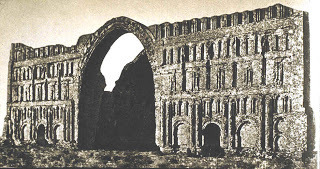 http://www.cais-soas.com/CAIS/Architecture/ayvan_e_khosrow.htmhttp://www.islamic-architecture.info/WA-IQ/WA-IQ-019.htm
http://www.cais-soas.com/CAIS/Architecture/ayvan_e_khosrow.htmhttp://www.islamic-architecture.info/WA-IQ/WA-IQ-019.htmCtesiphon - Fallen City of the Sassanid Kings - Part Onehttp://slingsandarrowsblog.blogspot.co.uk/2012/10/ctesiphon-fallen-city-of-sassanid-kings.html
Published on December 04, 2012 02:48
November 20, 2012
Pope Julius II - Warrior Pope
He is the sanctimonious crusader against the corruption of Pope Alexander VI in The Borgias, but Cardinal Giuliano della Rovere, later Pope Julius II, was a pontiff with a record every bit as chequered as his more famous predecessor. Della Rovere is cast as a pious contrast to the loose moralled Rodrigo Borgia, but in truth had a track record of corruption in securing the election of Innocent VIII; Borgia’s predecessor. Having amassed great wealth from holding a succession of lucrative sees during his career, della Rovere had a string of palaces filled with sumptuous artwork and had fathered at least three children. There are rumours too of a homosexual affair with one Francesco Alidosi, a favourite whose corrupt governance of Bologna resulted in the city revolting against Papal rule. He was, in short, no saint.
Della Rovere, having survived various assaults upon his person during the pontificate of his bitter rival Borgia, was elected to the supreme office in 1503. His election as Pope Julius II followed the death of Alexander’s short lived successor Pius III, who had reigned for a mere 26 days. Della Rovere had no qualms about imitating Borgia’s methods in securing his own election through bribery. Having done so, he then issued a hypocritical bull against simony.
 Pope Julius II by Raphael
Pope Julius II by RaphaelJulius II had swiftly secured the imprisonment and exile of the infamous Cesare Borgia but the removal of the former Gonfaloniere had created a vacuum in which those princes who had been divested of their territory by the Borgias, now sought to regain it with Venetian support.
This brought Julius into confrontation with Venice, not-withstanding the fact that he owed his election in large part to Venetian backing. Demanding the return of those territories which Venice had appropriated, Julius embarked on a long running feud with the Venetian Republic that would have grievous consequences for Italy.
In 1508 Pope Julius concluded the formation of the League of Cambrai, by which he intended to dismember the Venetian Empire; inviting the Kings of France, Spain and Hungary and the Holy Roman Emperor Maximilian to descend upon the Italian Peninsula and carve up the territories currently under Venetian control; excommunicating the Doge and placing the city itself under Papal interdict in the following year.
The Venetians suffered a major defeat at the hands of King Louis XII at Agnadello and despite heroically defending Pavia against the combined forces of the League, nevertheless submitted unconditionally to Papal authority in a humiliating ceremony on the steps of St Peters in 1510.
The genie could not so easily be put back in the bottle however. Those forces which the Pope had invited into Italy with the promise of easy territorial pickings continued their depredations. In one infamous incident, civilians fleeing the sack of Vicenza had sought refuge in a network of caves only to be asphyxiated when the pursuing French soldiers elected to smoke them out.
Realising his error, Julius now turned against the French and their ally the Duke of Ferrara; the husband of Lucrezia Borgia whom he detested and whose lands he coveted. He concluded an alliance against them which included Spain, England, the Emperor Maximilian and even Venice. A fresh round of bloodshed was therefore visited upon Italy, in which Julius took a full and active part. Here was the warrior Pope; personally taking charge of the siege of the castle of Mirandola in the depths of winter 1511; supervising the siting of the cannons and enduring the freezing conditions encamped in a wooden hut within range of the defenders’ guns. On one occasion two of his cooks were killed by a shot from the ramparts much to his fury. The French relief army was delayed in coming to the assistance of the besieged garrison after their commander the hapless Seigneur de Chaumont was injured by a snowball in the face of all things and later fell off of his horse into a river. When the garrison finally surrendered, Julius allegedly quibbled over their request that he should spare their lives.
The war culminated in the Battle of Ravenna in 1512; one of the bloodiest encounters of the period. The French, although victorious in this encounter, suffered such losses as to force their withdrawal from Italy, threatened as they were by an invasion mounted in support of the Pope by the young King Henry VIII of England, although not before they had put Ravenna to the sack.
 Battle of Ravenna
Battle of RavennaJulius now presided over the Congress of Mantua which aimed to settle the territorial disputes arising from the war but the continuing animosity between the Pope and the Venetians and his refusal to allow Venice to keep any of the territory she had thought to regain through allying herself with the Pope ultimately drove the Republic into the arms of the King of France.
When Julius II died from a fever early in 1513 he left Italy once more threatened by a French invasion and a fresh round of mayhem and bloodshed proved to be his political legacy. This Pope then, should be remembered as a warmonger and man of blood. Julius, legend has it, once complained to Michelangelo that a statue to be raised in Bologna in his honour held a bible in its hand and insisted instead that it should hold a sword. The statue, torn down by the people of Bologna when they revolted against the exactions of Alidosi, was sold to the Duke of Ferrara who melted it down and made it into a canon which he named Julius.
The art-loving Julius’ patronage of Michelangelo, who at times feared for his life from the Pope’s wrath, nevertheless has left us with the incredible artistic legacy of the Sistine chapel and for that, I suppose, we can forgive him a lot.
Life of Julius II
http://www.luminarium.org/encyclopedia/julius2.htm
http://www.guardian.co.uk/artanddesign/2003/apr/30/artsfeatures
Statue of Julius II
http://www.ancientworlds.net/aw/Post/1016331
Sistine Chapel
http://www.loyaltybindsme.org/2012/11/the-sistine-chapel-ceiling.html
Published on November 20, 2012 01:31
November 13, 2012
The Hippodrome - Constantinople's Theatre of Dreams
Ah the hippodrome! Just imagine it; the roar of the crowd, the thunder of hooves, the rattle of wheels and the flying dust; charioteers risking life and limb for a moment’s fleeting glory.
With the demise of gladiatorial combat as the Roman Empire under Constantine embraced Christianity, the sport of chariot racing was left as the principle source of public entertainment for the Roman masses. In Constantine’s new capital the construction of the new hippodrome was a signature project. Constructed between 324 and 330 AD on the site of an earlier structure created in the reign of Septimus Severus, Constantine’s hippodrome was 450 metres long and had seating for some 30,000 spectators. It was a structure intended to impress and would provide the setting for imperial pageantry as well as popular entertainment.
Artistic treasures from around the Roman Empire were plundered for the beautification of Constantinople and no monument of the pagan past was considered sacred by the new Christian Emperor. The Hippodrome’s central spina; a raised structure around which the chariots would race, featured at its centre the serpent column; a victory monument looted from the ancient sanctuary of Delphi. The column depicted three serpents intertwined who balanced upon their heads a votive tripod dedicated to Apollo in celebration of the Greek victory at Plataea in 479 BC. More ancient still was the obelisk of pink Aswan granite brought from Karnak on the orders of Constantine’s successor Constantius II and eventually erected on the spina in 390 AD under the emperor Theodosius I. This monument was already eighteen centuries old when it was brought to Constantinople and its inscriptions told of the Syrian victories of Tuthmosis III.
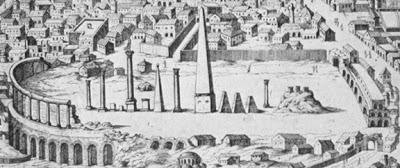
These two monuments and a second obelisk which was originally clad in bronze and may have served as a giant sundial are all that remain of the sumptuous decoration of the spina. The plinth which supports the so-called column of Theodosius depicts the Kathisma or imperial pavilion which stood on the eastern side of the hippodrome and had a direct link via a tunnel with the imperial palace. Here the emperor attended by a throng of silken toadies would appear before masses to share in the entertainment or to preside over grand occasions of state and sometimes even executions. A new emperor was not considered to be truly crowned until he had received the traditional acclamation of the factions in the hippodrome.
Under Justinian I (527-565 AD) the hippodrome saw some of its most dramatic events. None more so than the Nika Riots which broke out in 532. Chariot races were contested by four teams of which by this time only two were of any real importance; the Blues and the Greens. Their supporters formed rival factions whose detestation of each other knew no bounds and whose political and religious affiliations were often also at odds. Blues and Greens often took to breaking each other’s heads but when Justinian executed leading trouble makers from both factions he succeeded in uniting them against him. Whipped up into frenzy, the mob stormed from the hippodrome and embarked on an orgy of looting, burning and destruction which left much of the city a blackened ruin. Justinian, having contemplated fleeing the city, ultimately decided to send in the army and some thirty thousand rioters who had gathered in the hippodrome to call for the emperor’s overthrow were put to the slaughter.
The factions were not always so unruly. Their leaders were appointed by the state and they carried out ceremonial functions and even formed a militia for the defence of the city in times of crisis.
Three years after the Nika Riots with the city rebuilt, the general Belisarius returned triumphant from the reconquest of North Africa which had been under Vandal rule for a century. He had won crushing victories, liberated Carthage and captured the Vandal King Gelimer. He was permitted a triumphal procession which culminated in the hippodrome where Gelimer groveled on his knees before Justinian who looked down imperiously upon him before pardoning him to a life of comfortable exile. Amongst the captured treasures that were paraded around the arena, was no less venerable an object than the seven branched candlestick looted from the temple of Jerusalem by Titus and thence from Rome by the Vandals.
So much then for the politics, what about the racing?
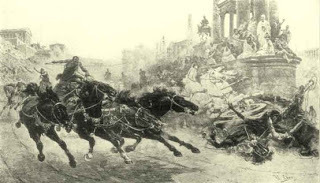 Four charioteers would contest each race, one for each faction; Blues, Greens, Whites and Reds. The chariots were drawn by four horses. Before the start competitors would draw lots for starting positions. The horses would be released from the starting pens or carceresat the northern end of the hippodrome and would race anticlockwise around the stadium. Races generally lasted for seven laps and a single day’s racing could comprise up to fifty races, divided into morning and afternoon sessions. Sometimes rival charioteers would swap teams from morning to afternoon in an arrangement known as diversium in order to settle for once and all who was the better man or for a particularly dominant charioteer to demonstrate that it was not to his horses alone that he owed his victories. One charioteer named Constantine is recorded as winning all twenty five races of the morning session and then going on to claim victory in twenty one races in the afternoon with a rival’s team of horses.
Four charioteers would contest each race, one for each faction; Blues, Greens, Whites and Reds. The chariots were drawn by four horses. Before the start competitors would draw lots for starting positions. The horses would be released from the starting pens or carceresat the northern end of the hippodrome and would race anticlockwise around the stadium. Races generally lasted for seven laps and a single day’s racing could comprise up to fifty races, divided into morning and afternoon sessions. Sometimes rival charioteers would swap teams from morning to afternoon in an arrangement known as diversium in order to settle for once and all who was the better man or for a particularly dominant charioteer to demonstrate that it was not to his horses alone that he owed his victories. One charioteer named Constantine is recorded as winning all twenty five races of the morning session and then going on to claim victory in twenty one races in the afternoon with a rival’s team of horses.The most celebrated charioteer of all was named Porphyrius, who was active during the late Fifth Century AD and into the Sixth, continuing to race into his sixties. Porphyrius is described on the bases of two surviving monuments erected in his honour on the spinaas having won hundreds of races and was unique in being the only charioteer to be permitted such a monument whilst he was still racing. Even more incredibly, Porphyrius boasts monuments which were erected by both the Green and the Blue factions, having changed his allegiance in mid-career.
Porphyrius may have had as many as eleven bronze statues raised in his honour on the spina. These were most likely destroyed and melted down when Constantinople fell to the forces of the Fourth Crusade in 1204 and the city was systematically looted. The most famous monument of all to survive from the Hippodrome were the four bronze horses which had stood atop the carceres and which were also looted in 1204. These thankfully were not melted down but on the orders of Doge Enrico Dandolo who led the attack on the city, were transported back to Venice and would for centuries grace St Marks, where they continue to reside to this day.
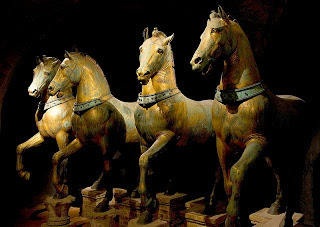
http://www.livius.org/cn-cs/constantinople/constantinople_hippodrome_1.html
http://www.aafla.org/SportsLibrary/JSH/JSH1981/JSH0803/jsh0803d.pdf
http://penelope.uchicago.edu/~grout/encyclopaedia_romana/circusmaximus/porphyrius.html
Published on November 13, 2012 01:22
October 29, 2012
Ctesiphon - Fallen City of the Sassanid Kings - Part One
Beside the River Tigris stand the remains of the royal capital of not just one but two great ruling dynasties of the ancient world. The remains of the city of Ctesiphon today lie some 20 miles from Baghdad and have seen better days.
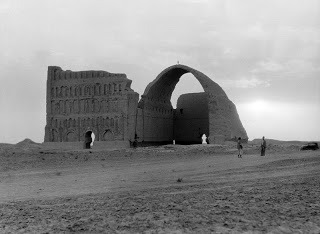
Ctesiphon began life as a small and unimposing cluster of dwellings across the river from the city of Seleucia-on-the-Tigris, capital of the Hellenistic Kings who at the height of their powers had ruled over a sprawling inheritance stretching from the shores of the Aegean to the Hindu Kush. These lands, hard-won by Alexander and bitterly contested by his successors had eventually come into the possession of Seleucus, the onetime commander of one of Alexander’s elite regiments and political survivor par excellence.
The descendants of Seleucus had ruled over their empire as the Greek speaking successors to the almighty kings of Persia that their illustrious ancestor had had a hand in overthrowing, with all the attendant pomp and bluster, until one day King Antiochus IV was humbled by a Roman Pro-Consul who took his sword and drew a line in the sand around the king and dared him to step over it. It was an eloquent illustration of the decay of the Seleucid Dynasty in the face of the inexorable rise of Rome, which had already deprived them of some of their wealthiest territories. By the time that Pompey the Great made his triumphant progress through the former Seleucid territories of the Near East, annexing a province here, setting up a petty client kingdom there, the Seleucid monarchs were no more; their line extinguished in fratricidal mayhem. It was not the Romans who had done for the Seleucids however, neither was it King Tigranes the Great of Armenia, whom Pompey had lately overthrown to take possession of a swath of formerly Seleucid territory that the Armenian ruler had made his own. Instead it was a formerly subject people of the Seleucid Kings who had struck the most decisive blow. The Parthians, a rough around the edges, formerly nomadic people who had occupied the north-eastern fringes of the Seleucid Empire and had paid little more than grudging lip service to the kings ruling in Seleucia, had risen against their nominal masters. Over the course of a century from attaining effective independence, the Parthians had grown from a nuisance to a dangerous rival to a deadly threat. In 139 BC, following a disastrous punitive expedition by the Seleucid King Demetrius II, the Parthian King Mithridates had taken Demetrius prisoner and held him captive for ten years. In 126 BC the Parthians advanced upon and took control of Seleucia. Rather than making it their own however, they left it as an entrepot of Greek merchants who lived under the protection of the new Parthian rulers and instead set up their capital across the river in Ctesiphon.
In 53 BC at the Battle of Carrhae, the formidable horse archers and cataphracts of Parthia had destroyed a Roman army under Marcus Crassus, inflicting on the Republic one of the worst defeats in its history. From this point Rome knew no deadlier rival and a grudging respect grew up between the two great empires that faced each other across the Euphrates.
The Parthian rulers however found themselves faced in the end with the same problems as their Seleucid predecessors; a vast and sprawling territory to control, fiercely independent subjects whose loyalty could never be taken for granted and a large and aggressive neighbour which would take advantage of any sign of weakness.
In 116 AD Rome’s greatest soldier-emperor Trajan did just this, advancing deep into Parthian territory and capturing Ctesiphon. Although stiffening resistance and trouble in Egypt forced Trajan to withdraw, he did so having stripped the Parthian capital of enormous wealth, much of it generated through a stranglehold on the silk trade which passed through Parthian territory.
By the time of the final, fatal revolt against Parthian rule in 226 AD, the Romans had repeated this feat twice more, each time withdrawing with vast quantities of loot. The credibility of the Parthian ruling house was in tatters. The revolt was led by Ardashir, a petty king who had laid claim to the ancient titles of Persian kingship and who now marched against the last Parthian ruler Artabanus IV, defeating him in battle and laying claim to all of his territories to usher in an era of a second great Persian Empire; that of the Sassanids. Ardashir rejected Ctesiphon with its Parthian associations and instead began redeveloping Seleucia as his seat of power; renaming it Veh Ardashir. The ever fickle Tigris had other ideas however, shifting its course to bring destruction to the new king’s efforts.
Under Ardashir’s son Shapur, Persia would prove once more to be a formidable opponent of Rome. His forces probed the Roman defenses and at times advanced deep into imperial territory, capturing strategic cities and inflicting stinging defeats on the forces of emperors Alexander Severus and Gordian III. His efforts culminated in the capture and sack of Antioch. In 260 AD Shapur would take prisoner and subsequently enslave the Roman emperor Valerian. Roman pride had never known a more terrible shame.
Shapur constructed himself a splendid new palace at Ctesiphon fit for a King of Kings. Little if anything remains of this structure. Some surviving mosaics from Shapur’s better preserved palace at Bishapur (below) however give an indication of the rich decoration that the palace would doubtless have featured.
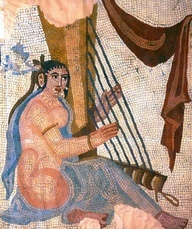
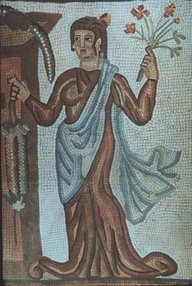
http://www.cais-soas.com/CAIS/Architecture/ayvan_e_khosrow.htm
http://www.islamic-architecture.info/WA-IQ/WA-IQ-019.htm
Published on October 29, 2012 18:19
October 23, 2012
Don't Bring a Longbow to a Gun Fight
Here is my last post for the time being at least on the Hundred Years War. Fittingly enough it is on the subject of the last engagement of that war; the Battle of Castillon in 1453. In its way Castillon was as seminal as Crecy, for just as that engagement heralded the arrival of the long bow as a battle-winning weapon that would secure a century of English ascendancy, so at Castillon the cannon came of age to play a decisive part in the battle.
The initiative in the war had turned decisively in favour of the French in the aftermath of the Battle of Formigny in 1450. This had been a disastrous defeat for the English under Sir Thomas Kyriell. An English army of 4000 men had been forced into an indefensible position and all but annihilated by a superior French force. Following this battle the French had overrun all Normandy and reclaimed it for King Charles VII, whilst refugees poured across the channel. In the following year the French had invaded the English territory of Guyenne, culminating in the seizure of Bordeaux.
 Battle of Formigny
Battle of Formigny In England there was widespread outrage. The Duke of Suffolk; whom many blamed for the debacle of the loss of Normandy and accused of conniving with the French, was arrested and beheaded with six strokes of a rusty sword.
The expedition of 1452 led by the septuagenarian Lord Talbot represented the last throw of the dice for the English to regain their territories in Guyenne and was supported by a widespread popular uprising. The following spring found Talbot advancing at the head of 6000 men towards a French army of 9000 who were laying siege to the town of Castillon.
Upon arrival Talbot received false intelligence that the French were fleeing. In fact under the direction of master-gunner Jean Bureau the French had dug in and were ready for a fight.
The French camp was a well-constructed affair, protected by an earth rampart, palisade and ditch and designed to allow the 300 French guns to enfilade their attackers.
Talbot, convinced that his enemies would not stand, thought to over-run the French camp and began an immediate attack with the forces that were to hand, not waiting for his whole army to come up. The English advanced in columns against the French with men at arms to the fore and archers to the rear. They did not lack for courage that day but it was a foolhardy enterprise and slaughter was the result as the English pressed forward; attempting to cross the ditch and storm the ramparts, only to be torn apart by murderous cannon fire at point blank range. The English nevertheless pressed on with the attack for a full hour as fresh men reached the battlefield and were thrown forward into the fray.
Talbot himself, the only man on horseback, had refused to wear armour in accordance with an oath he had sworn upon being ransomed from captivity following the fall of Caen. Instead, cloaked in purple, he offered an obvious target for the French gunners and a well-aimed cannonball struck his horse. Pinned beneath the stricken animal, old Talbot was hacked to pieces as a counter charge from the French camp swept away the broken English and further French reinforcements arrived to take them in the flank. By the time that Bureau’s guns fell silent, four thousand Englishmen lay dead. It was as profound an illustration of a change in the game of war as that made on the Western Front in 1914.
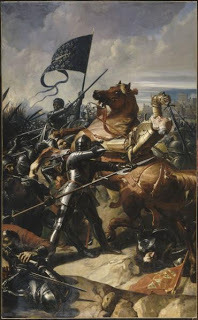 Battle of Castillon Within a few months of the Battle of Castillon, King Henry VI had lost his mind and Richard Duke of York had taken power in his stead. England stood on the brink of the Wars of the Roses; that murderous civil conflict ensuring that the territory lost in France would remain lost forever. The One Hundred Years War was at an end.
Battle of Castillon Within a few months of the Battle of Castillon, King Henry VI had lost his mind and Richard Duke of York had taken power in his stead. England stood on the brink of the Wars of the Roses; that murderous civil conflict ensuring that the territory lost in France would remain lost forever. The One Hundred Years War was at an end.Just two months before the flower of English chivalry were mown down at Castillon by French guns, another event of world changing proportions had occurred. At the other end of Europe the mighty walls of Constantinople, which had repelled invaders from east and west for a thousand years were at last breached by the massive siege artillery of the Ottoman Sultan Mehmet the Conqueror who then took the city, snuffing out at last the venerable Empire of Byzantium. The age of the gun had truly dawned.
http://militaryhistory.about.com/gi/o.htm?zi=1/XJ&zTi=1&sdn=militaryhistory&cdn=education&tm=12&gps=144_7_1600_754&f=11&tt=11&bt=1&bts=1&zu=http%3A//www.luminarium.org/encyclopedia/lossofguienne.htm
http://militaryhistory.about.com/od/battleswars14011600/p/castillon.htm
https://plus.google.com/u/0/117333054911795936844/posts/1SoM31qR9kL
Published on October 23, 2012 02:25
October 16, 2012
Doge Pietro Orseolo II – Mediterranean Statesman
Of all the rich pageantry that so characterised the Medieval heyday of the Venetian Republic, the most famous ceremony of all was the Festa della Sensa. This grand occasion, celebrated each year on Ascension Day was marked by the progress of the Doge aboard the state barge, the Bucentaur. The barge would make its way out to the edge of the Venetian lagoon, accompanied by a bustling flotilla of the great and the good, all festooned with banners and in their finery. Here, where the waters of the Adriatic lapped against the islands of the Lido, the Doge would stand upon the magnificent gilded prow of his barge and cast into the waters a ring, symbolising the marriage of his city to the sea; provider and protector of Venice’s wealth.
The rich symbolism of this ceremony, legend had it, had been endowed during the heady days of the ‘Peace of Venice’; a few weeks in the summer of 1177 when the Republic had played host to the Holy Roman Emperor Frederick Barbarossa and Pope Alexander III. Emperor and Pope had chosen Venice as the ideal neutral setting in which to set aside their differences and bury the hatchet after years of bitter struggle which had brought misery to Italy. As the blessings of peace descended, the Pope expressed his gratitude to Doge Ziani by presenting him with that first consecrated ring.

The origins of the ceremony went back further than this celebrated occasion however to the reign of the man who arguably set Venice on her path to greatness. Doge Pietro Orseolo II.
Orseolo came to power at a time when factional strife was rife amongst the leading Venetian families and relations with both the Byzantine Empire to the east and the resurgent Holy Roman Empire under the Ottonian Dynasty were somewhat shaky. Venice had assisted in Emperor Otto II’s failed attempt to seize Byzantine territories in the south and had then come within a whisker of being invaded by Imperial forces when Otto had been drawn into the machinations of the Coloprini family. In return for Otto’s assistance in ousting their deadly rivals the Morosini, the Coloprini had been willing to trade the freedom of the city and enfief Venice to the emperor. Otto’s death had curtailed the Imperial campaign against Venice. Nevertheless when Orseolo, (whose father had formerly been Doge and was subsequently canonised), was elected to office in 991, relations with both empires remained frosty.
Doge Orseolo set out at once to restore Venice’s international reputation; agreeing a treaty with Byzantine Emperor Basil II ‘The Bulgar Slayer’ which promised the support of the formidable Venetian fleet for his prodigious military efforts. In return Basil granted the Venetians a raft of trading privileges in Constantinople and beyond which formed the basis for Venice’s domination of eastern Mediterranean trade.
Orseolo next turned his persuasive charms on the new sixteen year old Emperor of the West Otto III. Otto, who dreamed of a restored Roman Empire with himself at its head and later moved his court to Rome, was dazzled by his reception as the guest of the Doge when he visited the city and soon granted similar privileges to Venetian merchants throughout his territories.
Having won the good will of the leaders of the Christian world Orseolo did not stop there but dispatched envoys to every Muslim court around the Mediterranean, happy to engage in diplomacy at a time when most of the princes of Christendom would have scorned parleying with the infidel. The Venetians were generally well received and profitable commercial relations were established. Orseolo, it seemed, was happy to do business with anybody. For those who would steal from the Republic however, he had only cold steel.
In the year 1000 Orseolo set out at the head of his fleet bound for the Dalmatian coast, where he determined to put an end to the Croatian pirates who plagued the settlements and shipping there. From his mast head flew for the first time in anger the banner of St Mark.
The whirlwind campaign through the Dalmatian islands scoured the pirates from their nests and all resistance was crushed. The last diehards held out in the fortress of Lagosta which surrendered following a bold assault by the Venetians. Having received the submission of all the settlements of the Dalmatian coast Orseolo returned to a hero’s welcome. It was in celebration of this achievement that the Ascension Day ceremony, in which the Doge would offer up a prayer for calm waters and a blessing on all Venetian maritime endeavors, was inaugurated.
 In 1004 Orseolo once more led the Venetian fleet into action, this time against the Saracens who were besieging the Byzantine city of Bari in southern Italy. Orseolo’s fleet broke the blockade and successfully brought supplies to the beleaguered city before engaging the Saracen fleet in three days of combat which ended in Venetian victory. The gratitude of Emperor Basil II was such that it secured a Byzantine royal bride for Orseolo’s son and heir Giovanni. The arrival of the Princess Maria caused a considerable stir in Venice and there was scandal at her oriental extravagance, daily bathing, exotic perfumes and most shocking of all, her use of a fork to eat her meals.
In 1004 Orseolo once more led the Venetian fleet into action, this time against the Saracens who were besieging the Byzantine city of Bari in southern Italy. Orseolo’s fleet broke the blockade and successfully brought supplies to the beleaguered city before engaging the Saracen fleet in three days of combat which ended in Venetian victory. The gratitude of Emperor Basil II was such that it secured a Byzantine royal bride for Orseolo’s son and heir Giovanni. The arrival of the Princess Maria caused a considerable stir in Venice and there was scandal at her oriental extravagance, daily bathing, exotic perfumes and most shocking of all, her use of a fork to eat her meals.Tragedy struck the Orseolo family within a year of the Princess’ arrival. Plague broke out in the city and carried off both Giovanni and Maria. Heartbroken, Pietro retired from public life, having raised his younger son Otto to share power with him. He died in 1008. His achievements had secured the good will of both empires and had served to make Venice the pre-eminent commercial power in the Mediterranean; a position she would retain for centuries to come. It was fitting therefore that as the Venetians set out in pomp and splendour each year to renew their special relationship with the sea, that they remembered their first great Doge; Pietro Orseolo II.
The Festa Della Sensa
http://venicexplorer.net/tradizione/sensa.php
The Peace of Venice 1177
http://avalon.law.yale.edu/medieval/venice.asp
Published on October 16, 2012 01:42
October 8, 2012
Robert Blake - Nelson's Hero
As you may be aware I live in Huntingdon Cambs: A thriving metropolis and hotbed of culture filled with beautiful people is not how I would choose to describe the place. Nevertheless in addition to the accolade of making the front cover of the book ‘Crap Towns’ Huntingdon has produced no less than two great leaders of our country; Oliver Cromwell and John Major.
Sir John has yet to get his own museum but when future generations look back on his achievements I am sure they will one day erect one. The former school house in which young Oliver Cromwell received his early education however, has been turned into a very decent little museum dedicated to the great man’s life and times. Despite being a lover of history and living in Huntingdon for no less than twelve years, I had never visited it. I cannot really justify this oversight on any grounds but sheer idleness.
Last week I finally got around to checking it out. I was genuinely impressed by the quality and quantity of the artefacts that the museum possessed and how well put together it was and felt that it should be held up as an example of how to create a museum in a small space. I nevertheless found myself no more enamoured of warty, puritanical, Christmas-hating Cromwell than I was before.
Instead I was intrigued by a small display featuring a sword which had once been wielded by Robert Blake, and read with great interest of the career of this capable soldier and sailor who should definitely be better known in the pantheon of English military heroes.
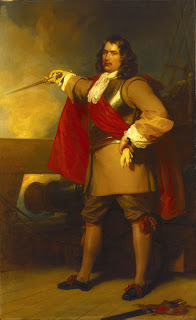
Robert Blake was a well-to-do merchant and member of parliament from Somerset and an unlikely hero. During the English Civil War he rose to prominence as a capable and dogged commander. His defence of thrice besieged Taunton, during which he famously declared that he had four pairs of boots and would eat three of them before he surrendered gained him celebrity status.
It was following his appointment in 1650 as General at Sea however that Blake truly made his mark and he soon demonstrated a keen grasp of naval tactics. Rising tensions between Cromwell’s Commonwealth and the Dutch Republic led to the outbreak in 1652 of the First Anglo Dutch War. Hostilities commenced when a Dutch fleet refused to dip their ensign in respect when they encountered Blake’s squadron off Dover. Incensed, Blake promptly opened fire and five hours later the superior Dutch force had been scattered in disarray.
 In the first major clash of the war Blake inflicted a stinging defeat on the Dutch at Kentish Knock, (pictured) which resulted in Parliament deciding to dispatch a fleet to the Mediterranean; underestimating the strength of their enemies across the North Sea. Later that year Blake’s nemesis Admiral Maarten Tromp gave his depleted forces a bloody nose off Dungeness.
In the first major clash of the war Blake inflicted a stinging defeat on the Dutch at Kentish Knock, (pictured) which resulted in Parliament deciding to dispatch a fleet to the Mediterranean; underestimating the strength of their enemies across the North Sea. Later that year Blake’s nemesis Admiral Maarten Tromp gave his depleted forces a bloody nose off Dungeness.Blake was at the heart of the fighting during the Battle of Portland which raged along the length of the English Channel for three days in the following January. Blake’s squadron was isolated and given a pounding by Tromp and Blake was wounded in the thigh during the engagement. Nevertheless the Commonwealth Fleet had by far the better of the battle and Blake led his battered forces in pursuit of the Dutch admiral who was driven to sailing dangerously close inshore in order to escape annihilation.
Blake’s wound, from which he never fully recovered, forced him to play a bit part in the Battle of the Gabbard and to miss the final decisive Battle of Scheveningen in which Tromp was killed. It was Blake nonetheless who was the architect of these victories and indeed of the naval tactics which were to become the hallmark of the great age of sail. His fighting instructions laid out for the first time the principles by which fleets were to engage the enemy fighting in line rather than ship to ship or in small squadrons.
Making a partial recovery, Blake set out to sea once more in 1654 where he continued to innovate. His action against Barbary Corsairs in Porto Farina was the first successful action by ships employing gunnery against shore batteries. Following the outbreak of the Anglo-Spanish war in the following year, Blake blockaded Cadiz throughout the winter of 1656-57; another naval first. Later in 1657 Blake conducted a daring raid on the port of Tenerife; leading his fleet into the harbour, battering the shore defences into silence and destroying every ship in the port. It was this action which prompted Nelson to declare ‘I do not reckon myself the equal of Blake.’ when contemplating a similar attack on the same target.
Within a year of this triumph Blake was dead, succumbing to ill health stemming from that old leg wound. He was given a state funeral and laid to rest in Westminster Abbey only to be disinterred and reburied in a nearby churchyard after the Restoration. This was done in spite of Blake not having taken an active part in the trial and execution of Charles I, although he was a stalwart of the Parliamentarian cause. It was nevertheless a gross act of ingratitude to a man who laid the foundations of British naval dominance.
http://www.british-civil-wars.co.uk/texts/fighting-instructions-1653.htm
http://www.cambridgeshire.gov.uk/leisure/museums/cromwell
Published on October 08, 2012 16:39
October 4, 2012
Beating the French - Again!
Just read an article by Bernard Cornwall lamenting that the Battle of Poitiers is not better known. I suspect he is about to do something about that. Well if we're talking underappreciated battles of the Hundred Years War I'll see your Poitiers Mr Cornwall and raise you Verneuil!
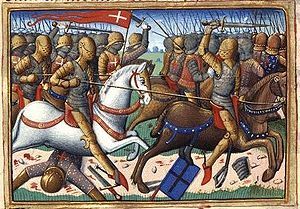
What could be better to raise our spirits this morning than a crushing English victory over the French? How about crushing English victory over the French and Scots at the same time!
I knew already of course of the Battles of Crecy, Poitiers and Agincourt, but Verneuil does not trip off the tongue in the same sentence. No kings did battle at Verneuil and it sits in the historical shadow cast by other better known events. It was arguably just as significant as those better known clashes however.
The battle was fought in August 1424. King Henry V, victor of Agincourt and conqueror of Normandy had died two years previously. Charles VI, the mad king of France, had followed him to the grave within months. This left the infant Henry VI on the throne of England and the hapless Dauphin Charles VII ruling over the south of France from Bourges. Meanwhile, true power rested with the regent John Duke of Bedford who held sway over the English possessions sprawling across the north of France, which now included the royal capitals of Paris and Reims.
In their efforts to eject the English, the forces of the Dauphin were ably assisted by the Army of Scotland commanded by the Earls of Douglas and Buchan. It was the Scots indeed who had facilitated the French recapture of the strategically important town of Verneuil, since the town’s people could not differenciate between Scotsmen and Englishmen.
The Duke of Bedford soon marched on Verneuil, eager to retake the town. The Franco-Scottish force, under the command of Agincourt veteran the Duke of Alencon and the Viscounts of Aumale and Narbonne prepared to meet the English in battle, forming up across the road to Verneuil; the French on the left, the Scots on the right, with Italian mercenary cavalry deployed on the wings.
With Bedford having dismissed his Burgundian allies for siege duties elsewhere, the French force was significantly larger than the English; outnumbering them by perhaps as many as two to one. Bedford therefore elected to fight a defensive battle; forming up his dismounted men–at-arms in line with archers on the wings who were protected by a barrier of stakes driven into the ground, though the ground was baked hard and the archers struggled to drive the stakes in.
Battle commenced when the Milanese mercenary cavalry on the French left charged against the English archers and succeeded in breaking through to fall upon the English baggage which was laagered to the rear. Here however they ran into a second reserve force of archers and were driven off in disarray by a hail of arrows. The cavalry on the other wing did not even attempt to engage the English archers opposite them but instead made straight for the baggage so as not to miss out on any plunder. Here they too fell foul of the longbowmen and fled from the storm of arrows that greeted them.
The French commanders meanwhile had thrown caution to the wind and charged the English men at arms opposite. In hard fighting the French were driven back. Unable to stand up to the onslaught they broke and fled, with many drowning in the moat surrounding the town. The Duke of Bedford himself is said to have killed many, wielding a pole-axe to deadly effect.
This left the Scots in an impossibly bad position; already engaged in hard fighting with the Earl of Salisbury’s men-at-arms on the English left, they then found themselves assailed on the flank by the reserve archers, who having driven off the cavalry, now exchanged bows for daggers and set upon the Scots. When Bedford’s victorious men at arms, having put the French to flight and ruin, also wheeled about and closed upon the Scottish rear, slaughter ensued. The fighting between these old adversaries was vicious, the Scottish commanders had sent a message to Bedford beforehand announcing that they intended to give no quarter. They received none. By the time it was over four thousand Scots including Douglas and Buchan lay dead. Aumale and Narbonne had also fallen. Alencon meanwhile was a prisoner, taken captive by Sir John Fastolf; the inspiration for Shakespeare’s Fallstaff.
English losses were slight by comparison; around a thousand men had fallen and only two men at arms had been killed.
The Battle of Verneuil finished the Scots as a fighting force in the conflict and secured English dominion of Normandy. Ultimately of course all would be lost as the English alienated their subjects and allies and finally lost the crucial support of the Duke of Burgundy. In the aftermath of Vermeuil however, few would have bet against further English successes.
For the Scottish connection see:
http://www.douglashistory.co.uk/history/Battles/Verneuil.htm
The 100 Years War by Desmond Seward
https://plus.google.com/u/0/117333054911795936844/posts/1SoM31qR9kL


What could be better to raise our spirits this morning than a crushing English victory over the French? How about crushing English victory over the French and Scots at the same time!
I knew already of course of the Battles of Crecy, Poitiers and Agincourt, but Verneuil does not trip off the tongue in the same sentence. No kings did battle at Verneuil and it sits in the historical shadow cast by other better known events. It was arguably just as significant as those better known clashes however.
The battle was fought in August 1424. King Henry V, victor of Agincourt and conqueror of Normandy had died two years previously. Charles VI, the mad king of France, had followed him to the grave within months. This left the infant Henry VI on the throne of England and the hapless Dauphin Charles VII ruling over the south of France from Bourges. Meanwhile, true power rested with the regent John Duke of Bedford who held sway over the English possessions sprawling across the north of France, which now included the royal capitals of Paris and Reims.
In their efforts to eject the English, the forces of the Dauphin were ably assisted by the Army of Scotland commanded by the Earls of Douglas and Buchan. It was the Scots indeed who had facilitated the French recapture of the strategically important town of Verneuil, since the town’s people could not differenciate between Scotsmen and Englishmen.
The Duke of Bedford soon marched on Verneuil, eager to retake the town. The Franco-Scottish force, under the command of Agincourt veteran the Duke of Alencon and the Viscounts of Aumale and Narbonne prepared to meet the English in battle, forming up across the road to Verneuil; the French on the left, the Scots on the right, with Italian mercenary cavalry deployed on the wings.
With Bedford having dismissed his Burgundian allies for siege duties elsewhere, the French force was significantly larger than the English; outnumbering them by perhaps as many as two to one. Bedford therefore elected to fight a defensive battle; forming up his dismounted men–at-arms in line with archers on the wings who were protected by a barrier of stakes driven into the ground, though the ground was baked hard and the archers struggled to drive the stakes in.
Battle commenced when the Milanese mercenary cavalry on the French left charged against the English archers and succeeded in breaking through to fall upon the English baggage which was laagered to the rear. Here however they ran into a second reserve force of archers and were driven off in disarray by a hail of arrows. The cavalry on the other wing did not even attempt to engage the English archers opposite them but instead made straight for the baggage so as not to miss out on any plunder. Here they too fell foul of the longbowmen and fled from the storm of arrows that greeted them.
The French commanders meanwhile had thrown caution to the wind and charged the English men at arms opposite. In hard fighting the French were driven back. Unable to stand up to the onslaught they broke and fled, with many drowning in the moat surrounding the town. The Duke of Bedford himself is said to have killed many, wielding a pole-axe to deadly effect.
This left the Scots in an impossibly bad position; already engaged in hard fighting with the Earl of Salisbury’s men-at-arms on the English left, they then found themselves assailed on the flank by the reserve archers, who having driven off the cavalry, now exchanged bows for daggers and set upon the Scots. When Bedford’s victorious men at arms, having put the French to flight and ruin, also wheeled about and closed upon the Scottish rear, slaughter ensued. The fighting between these old adversaries was vicious, the Scottish commanders had sent a message to Bedford beforehand announcing that they intended to give no quarter. They received none. By the time it was over four thousand Scots including Douglas and Buchan lay dead. Aumale and Narbonne had also fallen. Alencon meanwhile was a prisoner, taken captive by Sir John Fastolf; the inspiration for Shakespeare’s Fallstaff.
English losses were slight by comparison; around a thousand men had fallen and only two men at arms had been killed.
The Battle of Verneuil finished the Scots as a fighting force in the conflict and secured English dominion of Normandy. Ultimately of course all would be lost as the English alienated their subjects and allies and finally lost the crucial support of the Duke of Burgundy. In the aftermath of Vermeuil however, few would have bet against further English successes.
For the Scottish connection see:
http://www.douglashistory.co.uk/history/Battles/Verneuil.htm
The 100 Years War by Desmond Seward
https://plus.google.com/u/0/117333054911795936844/posts/1SoM31qR9kL
Published on October 04, 2012 01:30
Slings and arrows
Nuggets of history from the author of 'The Battles are the Best Bits'.
Nuggets of history from the author of 'The Battles are the Best Bits'.
...more
- Simon B. Jones's profile
- 22 followers



